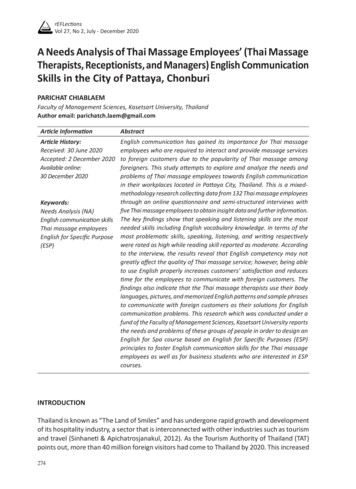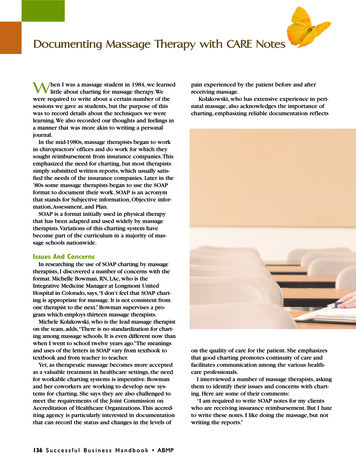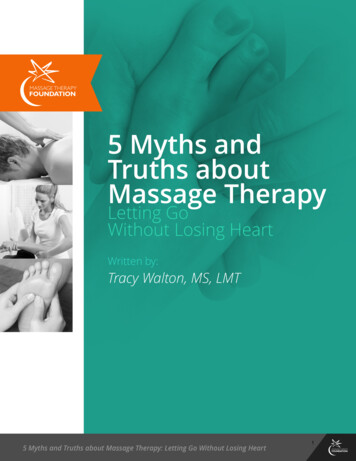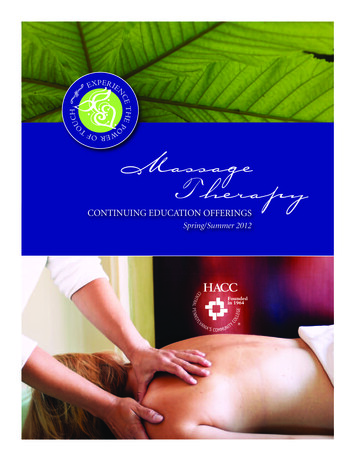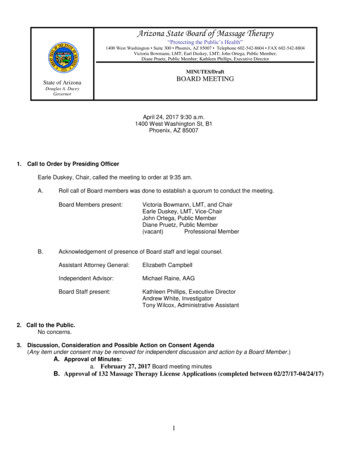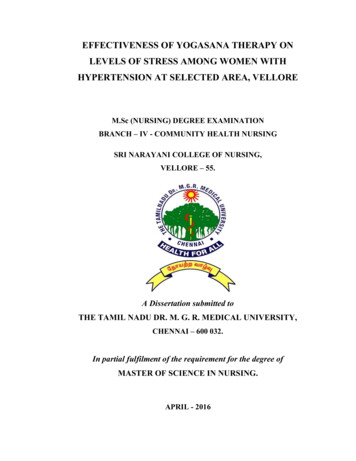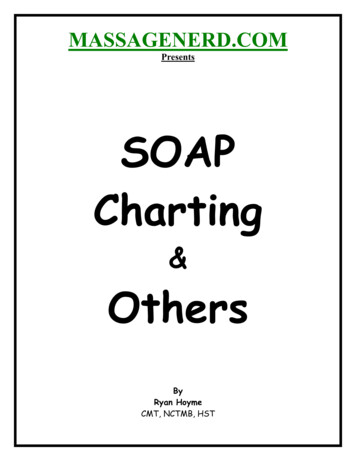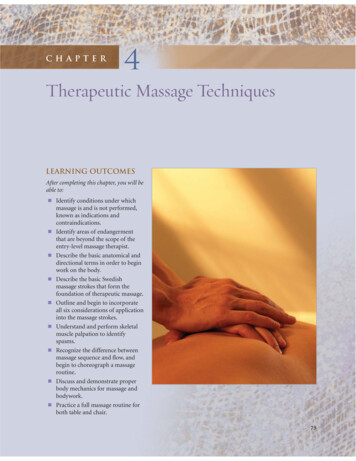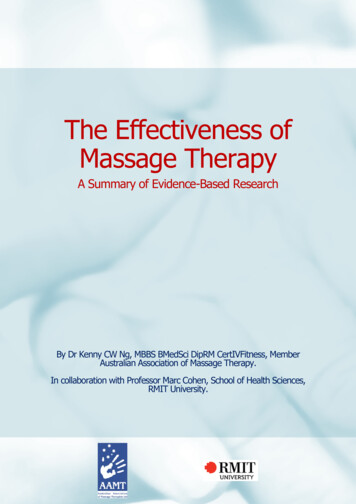
Transcription
The Effectiveness ofMassage TherapyA Summary of Evidence-Based ResearchBy Dr Kenny CW Ng, MBBS BMedSci DipRM CertIVFitness, MemberAustralian Association of Massage Therapy.In collaboration with Professor Marc Cohen, School of Health Sciences,RMIT University.The Effectiveness of Massage Therapy1Contents
ContentsPreface . 3CEO message. 4Introduction . 5Methods . 6Results . 11Discussion . 20Conclusions . 24References . 25Appendix I: Search strategy . 35Appendix II: Studies excluded due to time constraints in obtaining full-text article . 38Appendix III: Summary of systematic reviews . 39The Effectiveness of Massage Therapy2Contents
PrefaceThe purpose of this reportAlthough massage therapy is recommended and administered to various extents byhealthcare practitioners and patients alike, research evidence is required to advocatemassage therapy effectively and safely.This report reviews and collates existing evidence based research into the effectiveness ofmassage therapy, identifies recommendations for clinical practice and highlights researchgaps. It is designed to be a reference tool for those interested in the available evidenceabout the effectiveness of massage therapy.Who should read this report? Massage therapists;Practitioners of complementary and alternative medicine;GPs and allied health professionals; andResearchers in the area of health, complementary and alternative medicine.The Effectiveness of Massage Therapy3Preface
Australian Association of Massage TherapyCEO messageOn behalf of the Australian Association of Massage Therapists,I am pleased to present ‘The Effectiveness of MassageTherapy’ report.This report presents the body-of-knowledge of evidence-basedresearch into the effectiveness of massage therapy, comprisinga review of 740 existing Australian and international, academicresearch papers, published between 1978 and 2008.The research includes systematic reviews, randomisedcontrolled trials, comparative studies, case-series/studies andcross-sectional studies covering acupressure, bowen therapy,lymphatic drainage, myofascial release, reflexology, rolfing,shiatsu, Swedish massage, sports massage, infant massage,tuina and trigger point therapies/modalities.Key findings of this literature review show: A growing body of research supports massage therapy as being an evidence-basedtherapeutic modality There is strong evidence supporting acupressure management of nausea andvomiting Massage therapy is effective in managing subacute/chronic low back pain, delayedonset muscle soreness (DOMS), anxiety, stress and relaxation, and helps support thewellbeing of patients with chronic and/or terminal diseases such as cancer. There are opportunities for further research into the benefits of massage therapy forinfants, depression and post-natal depression, labour pain, fibromyalgia,premenstrual syndrome, urinary symptoms in multiple sclerosis, myofascial pain andknee osteoarthritis. There is consistent and conclusive evidence that massage therapy is safe. However,the importance of qualified massage therapists adhering to appropriate scopes ofpractice, safety guidelines and ethical procedures is stressed. Clinicians are encouraged to collaborate with professional massage practitioners forbest practice management of patients who may benefit from massage therapy.We certainly hope that this groundwork provides remedial massage therapists,complementary and alternative medicine practitioners and the broader allied healthcommunity with a basis to pursue evidence-based practice, and that this report leads theway for future research in the field of massage therapy.I congratulate Dr Kenny Ng and thank Professor Marc Cohen, School of Health Sciences,RMIT University for their efforts in developing this report.Tricia HughesThe Effectiveness of Massage Therapy4CEO message
IntroductionMassage can be defined as “manual soft tissue manipulation, and includes holding, causingmovement, and/or applying pressure to the body.”1 Massage therapy is the practice ofmassage by accredited professionals to achieve positive health and well-being (physical,functional, and psychological outcomes) in clients.1,2 As a distinct allied health and/orcomplementary and alternative medicine (CAM) practice, massage therapy encompassesdifferent types of massage originating from Western and Eastern practice, alongside the useof various supplementary therapeutic modalities e.g. cupping and dry needling.2In Australia, a recent national survey showed that 70% of respondents used one of 17forms of CAM, with 45% of respondents having visited a CAM practitioner in the precedingyear.3 CAM use in the United States of America appear to be similar to Australia.4 HoweverCAM use in the United Kingdom was more protracted, with ten per cent of surveyrespondents receiving treatment from a CAM practitioner in a 12-month period.5 Amongstthe numerous forms of CAM surveyed, massage therapy ranked as one of the mostcommonly used.3,4,5Although massage therapy isrecommended and administeredIn 2007, a national survey of Australiansto various extents by healthcareshowed massage therapy ranked as one ofpractitioners and patients alike,the most commonly used complementaryresearch is required todetermine its efficacy andand alternative medicine practices.safety. Numerous systematicreviews of massage therapyhave been performed and using variable search strategies and inclusion criteria to evaluatesingle or multiple types of massage therapy.6-13 The broadest reviews were published byBeider et al6 and Moyer et al,11 yet these reviews are still quite limited. The review by Beideret al6 was limited to randomized controlled trials (RCTs) and case-studies within a paediatricpopulation, and the search terms used restricted the review to child/pediatric massage. Thereview by Moyer et al on the other hand used an exhaustive search strategy with definedmassage therapies, yet limited the search to RCTs and excluded infant populations. Moyer etal did however, collate data from the included studies and provided recommendations forfurther research and best practice.11Due to the nature of search strategies and inclusion/exclusion criteria, there were manystudies that assessed the effects and safety of massage therapy not found in publishedreviews. The scattered nature of massage-related studies makes it challenging to confidentlyidentify research evidence that can inform best practice. An archive that indexes theevidence of effectiveness for massage therapy would prove invaluable to assure access tothe breadth of existing evidence. Once established, enhanced evidence-based massagepractice would hopefully boost the growth of the massage profession and industry. TheMassage Therapy Research Database, administered by the Massage Therapy Foundationsince early 2000, appears to be the primary source of citations to massage therapyarticles.14 This established database indexes more than 4800 peer and non-peer reviewedjournal articles and books, including non-English literature, with a recent addition of realtime access to PubMed.14The Effectiveness of Massage Therapy5Introduction
With an evidence-based practice focus and explicit methodology to source studies forinclusion, the Australian Massage Research Foundation15 commissioned a body-of-knowledge(BOK), that would archive research evidence pertaining to effectiveness of massage therapy.Using a broader search strategy and inclusion criteria than previous reviews, this studysystematically identified and compiled primary and secondary evidence that evaluated theeffectiveness of massage therapy and presents a summary of the current state of massagetherapy evidence.MethodsCriteria for considering studies for this reviewType of studiesStudies published up to November 2008 that evaluated the effectiveness of massagetherapy for the management of health, medical conditions or clinical symptoms weresourced for this review. This included studies that reported on the safety of massagetherapies. Studies that assessed physiological effects of massage therapy were alsoconsidered for inclusion as these studies may lend support to further research or applicationin clinical practice.Primary and secondary studies such as systematic reviews, RCTs, comparative studies(quasi-RCTs, cohort and case-controlled), case-studies/series, and cross-sectional studieswere included. These comprised of quantitative and qualitative studies. Studies published inlanguages other than English were excluded unless an English abstract with sufficienteligibility information was available.Reviews were included when a systematic and explicit search strategy appropriate toaddress the question of the review was conducted. These reviews may provide eitherquantitative and/or qualitative summary, along with assessment of methodological quality ofincluded studies with or without a critical appraisal tool.Study populations*Included studies assessed measurable effects from massage treatment(s) relating to one ofthe following: a) Diseased body systems and medical conditions (where available) consistent withallopathic principles of medical diagnosesb) Special groupsI. Paediatrics (includes neonates, infants and adolescents)II. Obstetricsc) Clinical symptom(s)d) Sports and exercisee) Physiological change(s)Study participants were limited to human subjects. No age restrictions were applied.Type of interventions*The types of massage therapies that were included in the review are presented in Table 1.These massage therapies were executed solely or in combination, and involved hands-on,direct physical contact without utilization or supplementation of machines, devices,equipment or tools including needles (acupuncture/dry-needling), bands and seeds(acupressure). Manual therapy techniques commonly used by massage therapists includingtrigger point therapy, myofascial release, deep transverse friction were also included.The Effectiveness of Massage Therapy6Methods
Table 1: Massage therapies/techniques sourced for inclusion in this review AcupressureAromatherapyAyurvedicBowen therapyDeep TissueDeep Transverse FrictionHawaiian / Lomi-lomiIndian HeadInfantManual Lymphatic DrainageMyofascial ReleasePregnancy ReflexologyRemedialRolfing / Structural IntegrationSeatedShiatsuSportsSwedish (includes effleurage/petrissage)ThaiTraditional Chinese Medicine (TCM) including Tuina/QigongTragerTrigger point therapySpecific disciplines such as myotherapy, chiropractic, osteopathy and beauty therapy wereincluded if a massage component was specified within the treatment regime and if theeffects of massage therapy were measurable independently without confounding factors.Anatomical and internal massages such as cardiac, ocular, perineal, prostate, rectal andvaginal were excluded.*Systematic reviews included in this study were exempted from assessment of thesecriteria as these studies will hold specific inclusion criteria of primary research. Forinclusion into this review, systematic reviews needed to include massage therapy as atreatment modality.Search strategyGiven the objective and breadth of this review, it was not possible to search through allavailable databases. The search strategy applied was aimed at sensitivity more thanspecificity in detecting studies. Several databases were used to increase the sensitivity ofthe search as evidence on CAM can be found in different sources.16 The databases chosenfor this review were based on their sophistication to obtain a workable number of studies(limited to 2500 hits/database and 8000 hits in total). Five (5) electronic databasesavailable through RMIT University library website were searched to acquire studies forpotential inclusion in this review (Table 2). These databases combined at least one (1) majormainstreamα and one (1) major non-mainstreamβ medical database. EMBASE, SCOPUS, Webof Science and Proquest databases were not used because the workable number of hits wasunattainable even when search limits as listed in Table 3 were applied.Table 2: Databases searched in this review Evidence Based Medicine (EBM) Reviews α Cumulative Index to Nursing and Allied Health Literature (CINAHL) β MeditextPubmed (incorporating Medline)Allied and Complementary Medicine (AMED)The Effectiveness of Massage Therapy7Methods
Pilkington recommends that massage studies can mostly be identified through indexingterms, otherwise known as medical subject headings (MeSH), and that sensitivity can beincreased if a textword search is also performed.16 MeSH headings were used for the searchterm ‘massage,’ and where available the ‘explode’ function was applied (Table 3). Textwordsearches were carried out for all search terms, otherwise a keyword search was performed(Table 3 and 4). Citations and abstracts of studies identified through the electronicdatabases were imported and stored in an electronic
Massage Therapy Research Database, administered by the Massage Therapy Foundation since early 2000, appears to be the primary source of citations to massage therapy articles.14 This established database indexes more than 4800 peer and non-peer reviewed journal articles and books, including non-English literature, with a recent addition of real- time access to PubMed.14 In 2007, a national .File Size: 1MBPage Count: 51
